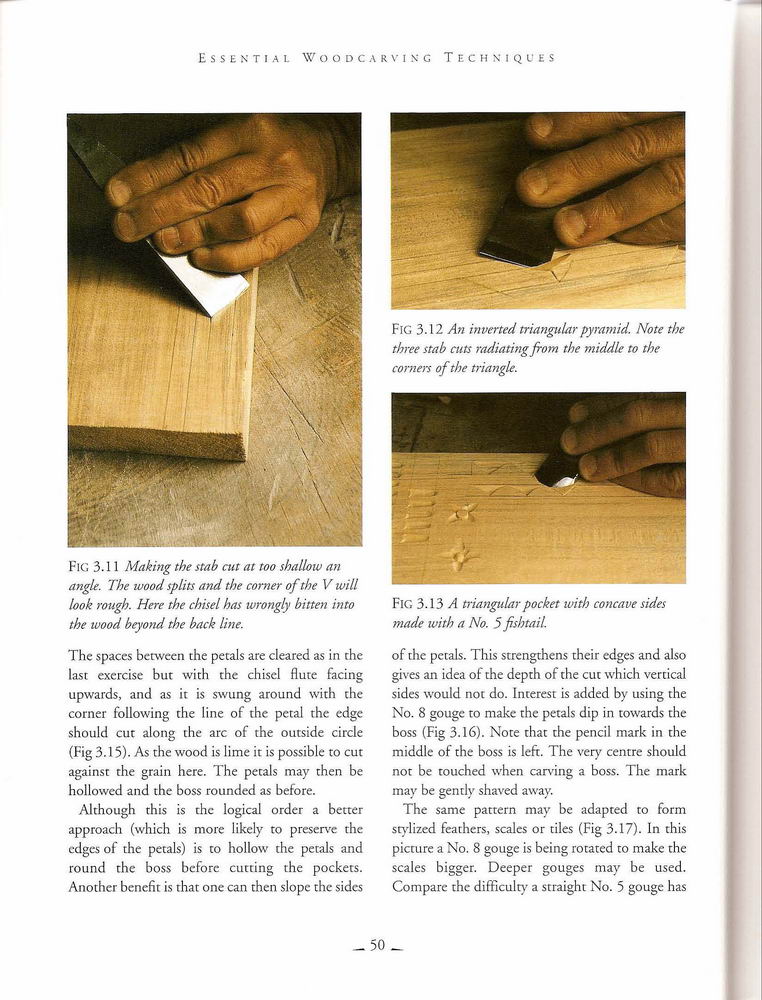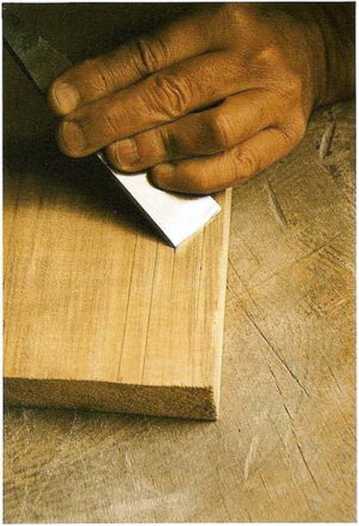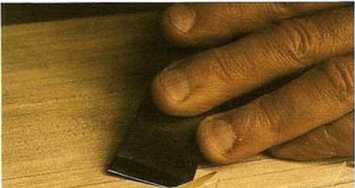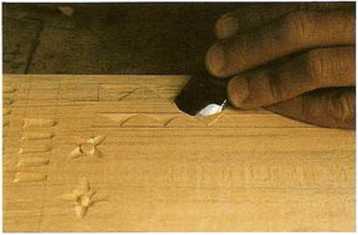essentÊrving°50

Essen tial W o o d c a r vin g Techniques


Fig 3.11 Making the stab aa at too shallow an angle. The wood splits and the corner of the V will look rough. Here the chisel has wrongly bitten into the wood beyond the back linÄ™.
The spaces between the petals are cleared as in che last exercisc but with the chisel flute facing upwards, and as it is swung around with the corner following the linÄ™ of the pctal the edge should cut along the arc of the outside circle (Fig 3.15). As the wood is limÄ™ it is possible to cut against the grain here. The petals may then be hollowcd and the boss rounded as before.
Although this is the logical order a better approach (which is morÄ™ likely to preservc the edges of the petals) is to hollow the petals and round the boss before cutting the pockets. Anothcr benefit is that one can then slopc the sides
\
FlG 3.12 An itwerted iriangular py rani id. NotÄ™ the three stab cuts radiating from the middle to the corners of the triangle.

FlG 3.13 A triangular pocket with concaoe sides madÄ™ with a No. 5 fishtail.
of the petals. This strengthens their edges and also gives an idea of the depth of the cut which vercical sides would not do. Interest is added by using the No. 8 gougc to make the petals dip in towards the boss (Fig 3.16). NotÄ™ that the pencil mark in the middle of the boss is left. The very centre should not be touched when carving a boss. The mark may be gently shaved away.
The same pattern may be adapted to form stylized fcathcrs, scalcs or tiles (Fig 3.17). In this picture a No. 8 gouge is being rotated to make the scales bigger. Deeper gouges may be used. Comparc the difficulty a straight No. 5 gouge has
— 50 _
Wyszukiwarka
Podobne podstrony:
essent?rving?68 Essen tial Woodcarving Techniques FlG 15.16 The fint cut into the serif on an M. Fig
essent?rving?72 Essen tial W o o d c a r vin g Techniques Alder {Alnus glutinosa) Pale yellow or pin
essent?rving?18 Essen tul Woodcarning Techniques Fig 1.29 A bench holdfast in use. Fig 1.28 A univer
essent?rving?34 Essen tial Woodcarying Techniques softwoods are evergreen and hardwoods are dcciduou
essent?rving?40 Essen tial Woodcarying Techniques FlG 2.20 Arrow Crosstree (Dick Onians), carued in
essent?rving?48 Essen tiał Woodcarving Techxiques Fig 3.5 From the bot tom: two correct chip cuts; t
essent?rving?58 Essen-tial Woodcarvig Techxiques Fig 4.10 Cu tti fig the cup. The gouge en ten the w
essent?rving?68 E S 5E NTI A L W O O D C A R VIN G TECHNIQLES Fig 5.6 The gouge can removeplenty of
essent?rving?72 Essen tial Woodcarving Techniques although the temptarion ro use a router co set clo
essent?rving?86 Essen tial W o o d c a r vin g Tech kiqu es fold. If these arc forgotten irrcversibl
essent?rving?52 Essen’ tial W o o d c a r v i n g Techniques Fig 3.18 A No. 3 fishtail being used to
essent?rving?16 Essen.tial Woodcarvmng Techsiques A clamp should be strong and have its heads in lin
essent?rving?98 Essential Woodcarving Techniques Fig 9.1 Various lines. The one on the left Incks in
essent?rving?20 Essen tial Woodcarving T e c h n i q u e sChoosing the BestDlRECTION OF THE GRAIN Th
essent?rving?24 E S ii E Nil A L W O O O C A R V l N O, T E C H X I Q L F. S Fig 11.14 The left sic
essent?rving?62 Essen tial Woodcary ing T e c h n i q u e s Top arm comes just Hal
system 115 mm i i ucn-.> Fig. 112. Fig. 11:*. Brud th<* fo»it upwards at ił»
essent?rving?59 Car ved Mo u l dix g s Fig 4.12 After the rim ofthe cup has been stabbed in, a chip
essent?rving?70 Es S E N TI A L W O O D C A R VING TeCHXIQUE$ Fig 15.23 The fishtail cutting the end
więcej podobnych podstron